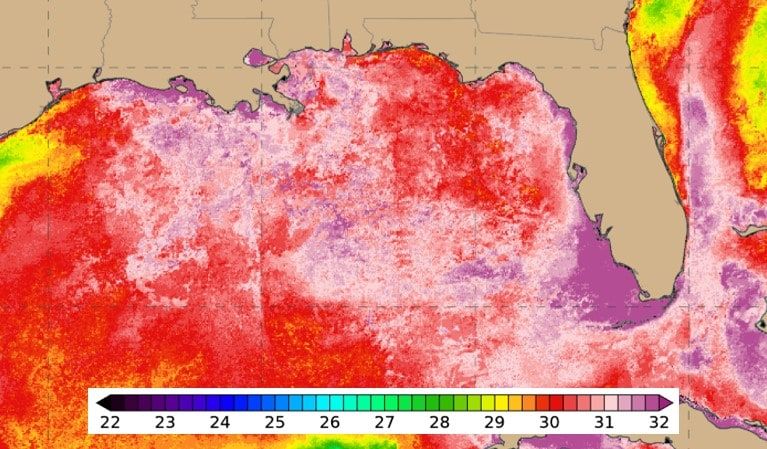Florida ocean temperatures at ‘downright shocking’ levels
Listen 4 min Comment on this story Comment Gift Article Share
Not only is Florida sizzling in record-crushing heat, but the ocean waters that surround it are scorching, as well. The unprecedented ocean warmth around the state — connected to historically warm oceans worldwide — is further intensifying its heat wave and stressing coral reefs, with conditions that could end up strengthening hurricanes.
Much of Florida is seeing its warmest year on record, with temperatures running 3 to 5 degrees above normal. While some locations have been setting records since the beginning of the year, the hottest weather has come with an intense heat dome cooking the Sunshine State in recent weeks. That heat dome has made coastal waters extremely warm, including “downright shocking” temperatures of 92 to 96 degrees in the Florida Keys, meteorologist and journalist Ben Henson said Sunday in a tweet.
“That’s boiling for them! More typically it would be in the upper 80s,” tweeted Jeff Berardelli, chief meteorologist and climate specialist at WFLA-TV in Tampa.
Advertisement
The temperatures are so high that they are off the scale of the color contours on some weather maps.
The warmth registers as a Category 3 out of 5 on the National Oceanic and Atmospheric Administration’s marine heat wave scale. NOAA defines a marine heat wave as a period with persistent and unusually warm ocean temperatures, “which can have significant impacts on marine life as well as coastal communities and economies.” The agency describes Category 3 as “severe.”
Such warm water temperatures “would be impressive any time of year, but they’re occurring when the water would already be rather warm, bringing it up to bona fide bathtub conditions that we rarely see,” Brian McNoldy, senior research associate at the University of Miami and hurricane expert for Capital Weather Gang, said in an email.
Advertisement
The toasty waters are influencing temperatures on land by raising the humidity, which makes it harder for temperatures to cool off at night. Numerous records for temperatures and heat indexes have been broken since mid-June, and the heat wave is expected to continue for at least a week. According to McNoldy, Miami’s heat index soared to 110 degrees on Monday and has reached at least 100 on 30 straight days.
Miami, Tampa and Fort Myers are expected to hit a heat index of 105 or higher on each of the next seven days, according to the The Washington Post’s heat tracker.
“It’s an astounding, prolonged heat wave even for a place that’s no stranger to sultry weather,” said McNoldy, who also cautioned that the warm waters could make tropical storms or hurricanes stronger. “It’s not something we like to see near land simply because it would allow a storm to maintain a high intensity right up to landfall or rapidly intensify as it approaches landfall.”
Advertisement
Hurricane forecasters have recently upped their predictions for the season in response to the rising ocean temperatures.
The marine heat wave is also causing coral bleaching, which can leave corals vulnerable to deadly diseases. NOAA’s Coral Reef Watch has recorded an “Alert Level 1” off the coast of South Florida. That is the second-highest level, described by NOAA as “significant bleaching likely.”
What’s important is accumulated heat stress. The map shows it’s at 4 to 5 weeks. Significant coral bleaching usually occurs when the DHW degree heating weeks) value reaches 4 weeks… and when it reaches 8 weeks severe/widespread bleaching at mortality is likely. 3/ pic.twitter.com/4kdt8yvKCP — Jeff Berardelli (@WeatherProf) July 10, 2023
Berardelli credited unusually light winds since late May, in addition to the heat dome, as contributing to the warming sea surface: “Typically Florida sees a nice breeze from the [southeast] but this summer pattern has been resilient,” he tweeted. “The water is warming under this stagnation!” Light winds can lead to stagnant waters, which prevent deeper, colder water from churning to the top, allowing the ocean surface to heat more quickly.
Advertisement
The hot waters around Florida are connected to record-breaking ocean heat worldwide. About 40 percent of the world’s oceans are facing a marine heat wave, NOAA reported. That is the highest percentage on record, and it could reach 50 percent by September.
Scientists also attribute the widespread heat of the global ocean waters to human-caused climate change, which has helped boost the oceans to record-warm levels.
Gift this article Gift Article
Source: The Washington Post


